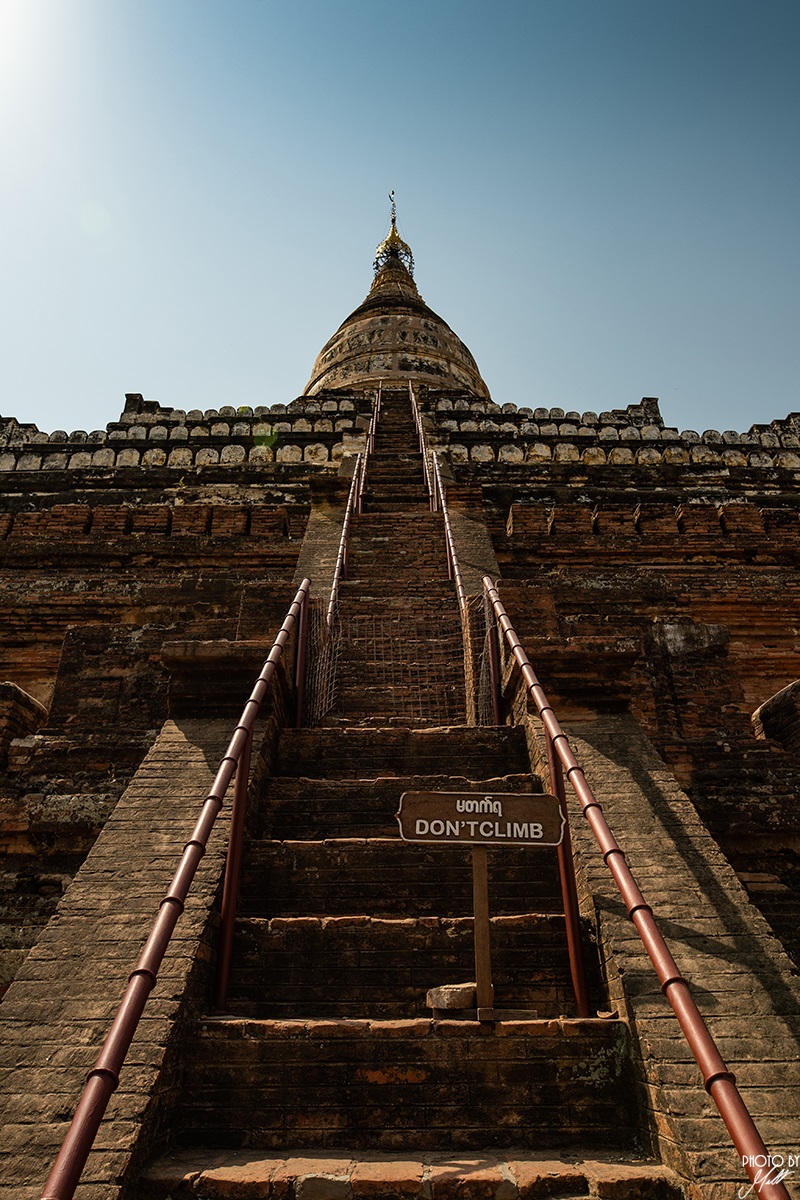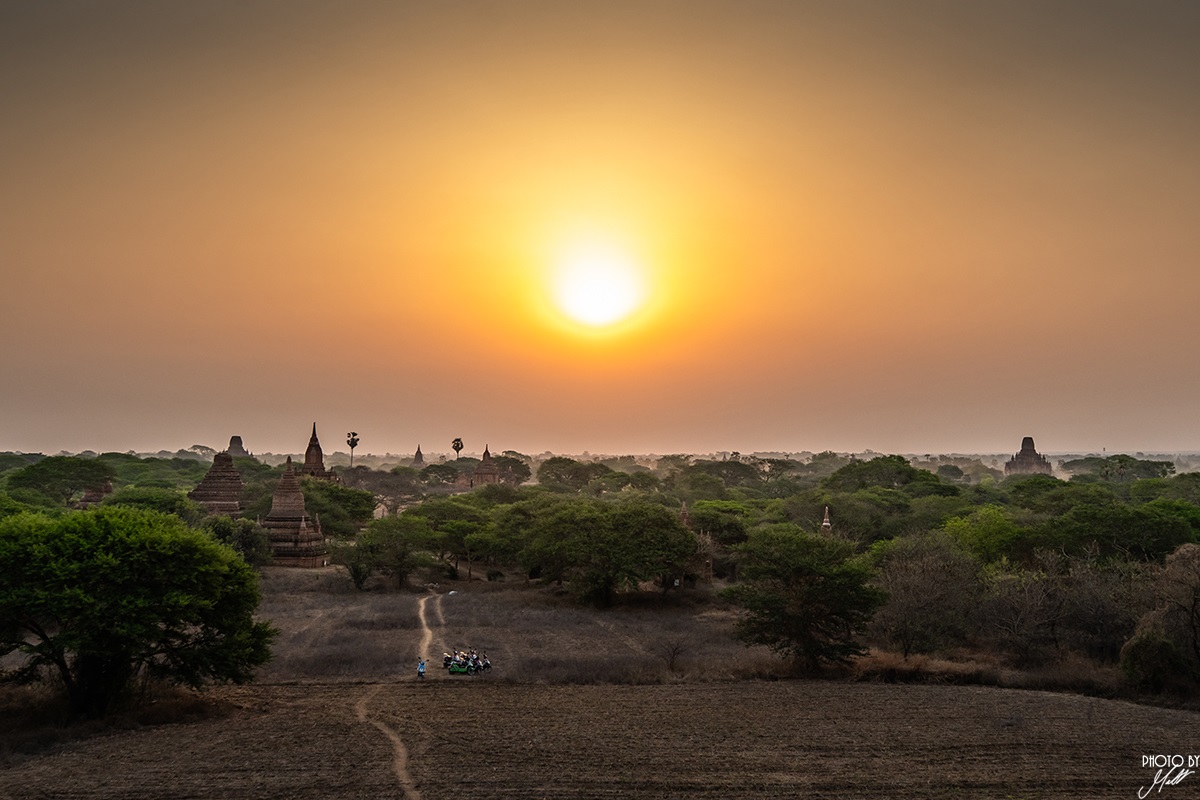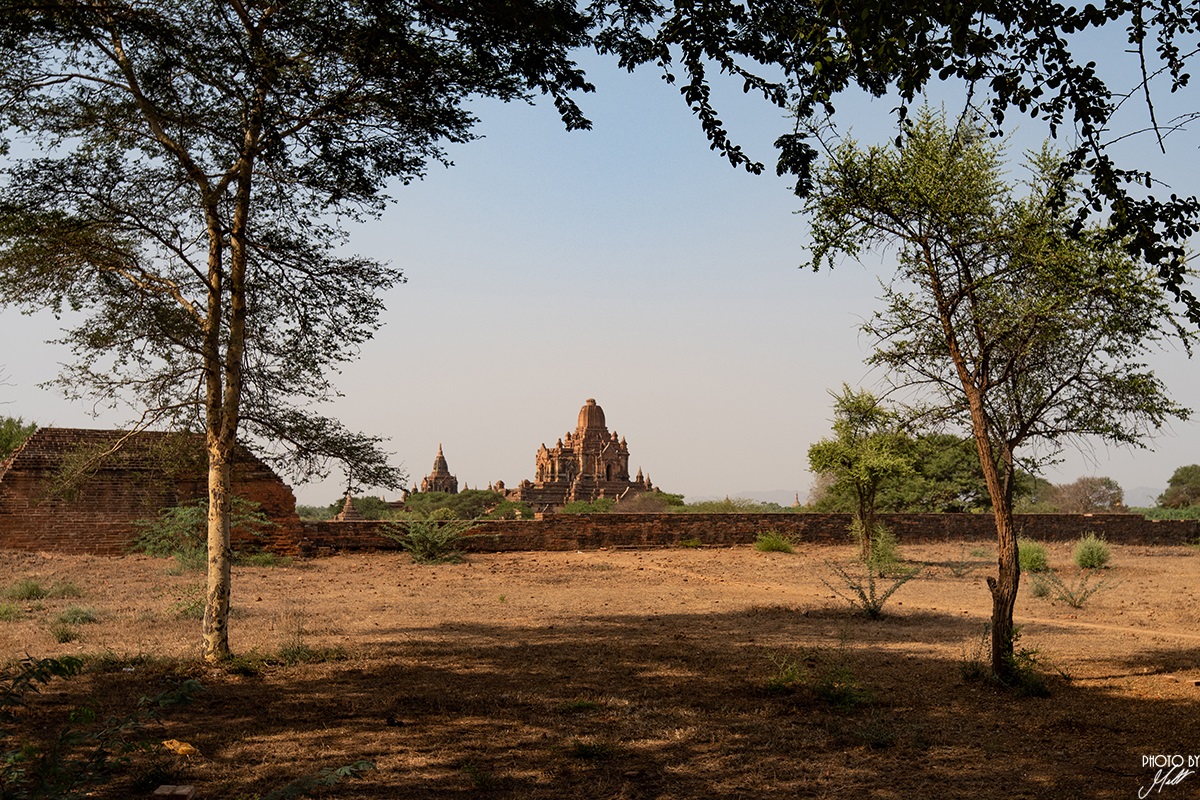BAGAN – Paradise lost
Bagan smells of dust. Dust is ubiquitous here, blown into the air by a stronger gust of wind or a passing car. After just a few hours in the wilderness, my backpack, just like me, is covered with a thin, yellowish layer. The view around, however, makes any inconvenience no longer relevant.
On the very first day of my stay in Myanmar, I was made aware that the main tourist season was over. Although I was in time before the monsoons, the hot, dry season that preceded it was also not the most convenient time to visit. On the first evening it turns out that the boat I planned to go down the Irrawaddy from Mandalay to Bagan does not currently operate, due to the low water level in the river. So I get to Bagan by JJ Express bus – a brand worth remembering, as this is probably the most comfortable way to travel by road in the whole country. I get there in the afternoon, not in the evening, as would be the case with a boat. This gives me an additional half a day to explore the area – and there is a lot to see, as the whole area covers an area of 104 km2. For 15,000 Kyat I rent an electric scooter for two and a half days. It will become my closest companion for the next two days.
The entire area is covered by a network of dirt roads and paths, allowing free exploration. This form of sightseeing is probably the most interesting – I meet maybe four other people throughout the afternoon. Without a plan, I move from one temple to another, completely absorbed with the magic of the surroundings. It is hard to rest, because after reaching one place, another one looms invitingly in the distance. Everything is silent and bathed in the rays of the sun slowly falling towards the west. Finally, I just stop the scooter in the middle of nowhere and with silent delight watch as the red ball disappears behind the Dhammayangyi temple.


I start the next day with a wakeup call at 4:30 am to get on the scooter in complete darkness and reach one of the viewpoints indicated to me at the hostel. When I reach my destination, I check several times if I am at the right place. The mound does not look very impressive, and the view from its top is so bland that I do not even set up a tripod. Wait a minute! – you will probably think if you’ve seen the characteristic photos of the sunrise over hundreds of temples, taken from the top of one of them – Why climb mounds when you can just climb one of the buildings? Well, last year things started to get complicated and the tourist Eldorado was hit in the face by the government. They began to close all temples with stairs, allowing access to their roofs. The official reason is the desire to protect monuments, and I can understand this argument to a large extent. The condition of some objects is so bad that the crowds of tourists could pose a threat to them (and vice versa). The problem arises when the buildings are completely renovated and access to them is prohibited for the sake of it. As an alternative, the Myanmar Department of Tourism offers the aforementioned mounds, or a visit to an architectural nightmare in the form of a tower erected next to a modern tourist resort, the best element of which is the exit door. There is also an option to fly a balloon for around 300 USD and apart from the price, this is definitely the best solution, offering a one-of-a-kind experience. Unfortunately, the balloon season lasts from October to April, so even this is not an option in my case. As it is said behind the scenes, in addition to the protection of monuments, the reason for the closure of temples may be the local government’s desire to push the region into the luxury tourism. Golf courses or five-star resorts do not match well with backpackers traveling the area on their own, hence an attempt to discourage low-budget tourists by significantly limiting their possibilities. How much truth is in it – hard for me to say.
Realizing that I cannot count on the officially proposed solutions, I decide to take matters into my own hands and find a temple that has not yet been fitted with bars. The sun is already hanging high when I manage to achieve my first, small success. In one of the buildings I find a wooden platform with a ladder leading to it. A little higher up, I find the dark corridor outlet. The corridor is quite an understatement in this case, because its dimensions are more like a ventilation shaft. The crossing requires some flexibility, but after taking a ninety-degree turn in these conditions, I manage to reach the top. Although the building is small and does not offer a stunning view, I still feel great satisfaction standing on its top. Above me the sun hangs at its zenith, plunging the entire area into 44C. Around me the temples and stupas rise above the trees, like chess pieces scattered for fun by some giant,. Even this substitute of a view from one of the larger buildings can arouse admiration. I am beginning to regret that I did not come to Myanmar at least a year earlier.
The rest of the day brings more exploration failures. I even make my way to some temples through bushes, as there is no path leading to them. All with the same effect in the form of iron bars blocking the passage. By the way, I learn that the spikes from the surrounding shrubs pierce the sole of the shoe and walking on dried branches is not the smartest idea. But straying off the beaten track also has benefits. I come across a herd of goats grazing among the ruins under the supervision of an elderly man and two young women. One of the animals at this point decides to give birth to a little goat. Combined with the surroundings and the lack of even a single tourist, the whole scene seems to be surreal. Another sunset finds me in the middle of nowhere and I slowly lose hope that I will find a good vantage point during my stay.
I start my last morning with the assumption that I will meet a representative of the local population who will show me a suitable place for a fee. The first chance comes fairly quickly, but the 20USD price tag is so ridiculous that I don’t even want to negotiate. So I wander on my two-wheeler, trying to let myself be found by someone with a greater sense of business. Annoyingly no one shows up. Perhaps they joined the wild crowd that stuck to the top of one of the viewing hills. Despite the considerable distance, I can hear the shouts and calls perfectly well. I ride away as quickly as possible, wondering in horror if this is just a new version of the Bagan experience. When I lose all hope, a young man rides up to me on a motorbike and proposes a sunrise from the roof of the temple. He asks for 5000 Kyat, so I agree to follow him without negotiation. After five minutes of driving in a cloud of dust ignited by the two-wheeled vehicle leading me, we reach a small temple, whose top has already been occupied by a group of tourists. I join the gathered people and watch in silence as the day awakens. For a moment it ceases to matter that I am not too high, or that the pictures can’t include the balloons rising in the sky. There is something magically mesmerizing about the Bagan sunrise. Something that makes the idea of spending over 300USD on an hour-long balloon flight pretty good.


As this is my last day, I decide to visit all the major temples on the “must-visit” list. After a few hours, however, I feel tired and the inhuman temperature is the least important factor here. After an intimate experience with off-road temples and stupas, it is painful to immerse yourself in the world of souvenir stalls and typical tourist groups. However, if you get there early enough, you will have all these special places to yourself, and they are popular for a reason, after all.
I leave Bagan with a strange mixture of unfulfilled feelings and the belief that in the past sixty hours I have done everything I could. I will have to come back one day in a different season, when the whole area will be embraced by the greenery erupting after the rainy season. Even though I am leaving, I’m filled with excitement about the next stage of the journey, which was one of the key points when arranging the entire trip. I’ll write more about it in the next part though.
PRACTICAL INFO
– Entire area ticket is required. It costs 25,000Kyat and you will likely be forced to purchase it upon arrival. Somehow, no one accosted me and the only moment when someone asked for a ticket was the sunrise on the nightmarish mound, when a man with an ID card asked me to show the ticket. After a short chat and me explaining that I don’t have any cash on me, he only pointed to the place of their office and wished me a nice day. Nobody asked for a ticket anymore.
– Explore on an electric scooter. The cost depends on the length of the rental and negotiation skills, but for 2.5 days I paid 15,000Kyat, which is about 10USD. Rentals are absolutely everywhere, so you won’t have any problems.
– Take a bandana to cover your nose and mouth. As you pass the first vehicle, you’ll appreciate this advice.
– Bagan can be reached by train (for the desperate), plane, bus and boat. The last option, although it lasts all day, is probably the most pleasant way.
– Stock up on maps.me. or mapy.cz . Without a map, you will likely get lost
– The temple that I climbed at sunrise is here: 21.105248, 94.523342 One of the nearby ones was also opened: 21.105296, 94.523324.
– Fantasia Garden: 21.110113, 94.520193 is a great place with overlook of the river, where you can relax and get something cold to drink.
– I personally slept in BaobaBed Hostel Bagan and I wholeheartedly recommend this place. Superb location off the beaten track, allowing easy access to the archaeological zone, great by hostel standards, breakfast included in the price and a swimming pool on the roof.








